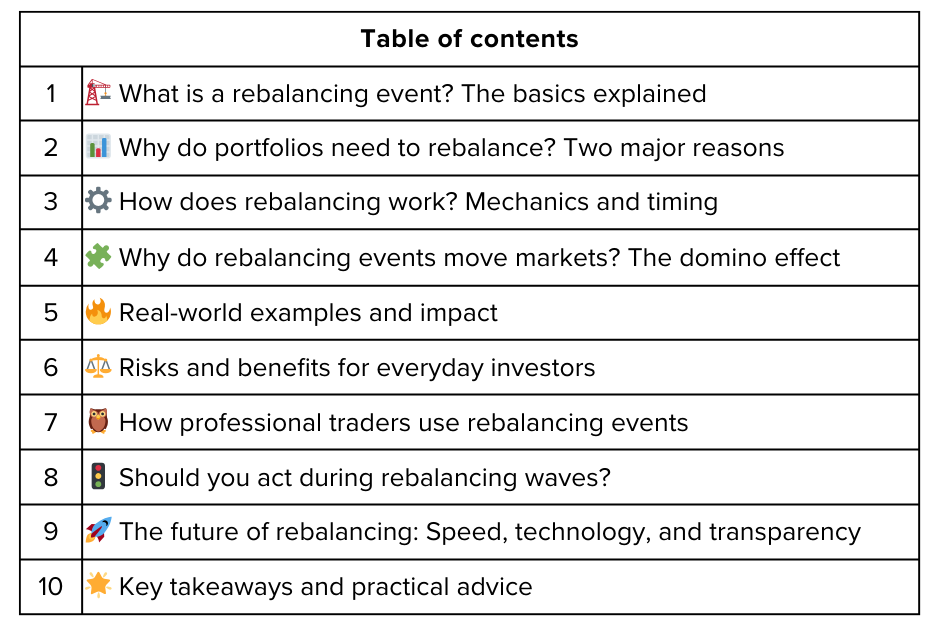What’s a rebalancing event and why does it move markets?
If you spend any time following financial news, you’ll notice that certain days seem a bit more hectic, stocks swing wildly, trading volumes explode, and analysts talk about “rebalancing events.” But what is a rebalancing event, and why does it make markets move in big ways? Whether you’re a new investor or a seasoned trader, understanding rebalancing is key to grasping the rhythm of Wall Street and protecting your portfolio. This guide will explain the concept, show its market impact, help you spot the signals, and give actionable advice for handling rebalancing waves in today’s world.
🔔 Don’t miss out!
Add winvestacrisps@substack.com to your email list so our updates never land in spam
What is a rebalancing event? The basics explained 🏗️
A rebalancing event is a scheduled adjustment of the investments inside a portfolio, index fund, or ETF. Over time, the value of different stocks, bonds, or sectors in a portfolio will change as markets fluctuate. This causes the mix of assets—the allocation, to drift away from the target. The aim of a rebalancing event is to bring things back in line by buying and selling investments to restore the original balance.
For example:
Suppose an index fund aims for 60% stocks and 40% bonds. After a good year for stocks, the fund might end up at 70% stocks and 30% bonds. To rebalance, the fund would sell some stocks and buy bonds to get back to its target mix.
Portfolio managers, pension funds, index providers (like the S&P 500), and big ETFs all rebalance periodically. These adjustments can happen quarterly, semi-annually, or annually, and sometimes when special events demand changes.
Why do portfolios need to rebalance? Two major reasons 📊
1. To keep risk consistent
Every investor sets a target for their portfolio to match their risk tolerance and financial goals. If the market moves and the portfolio drifts away from those targets, it might now carry more or less risk than intended. Rebalancing pulls things back in line, keeping the risk and return close to what you signed up for.
2. To follow the rules
Indexes and funds have strict guidelines. These can involve sector weights, the number of stocks, or country exposure. Managers must rebalance so the funds stick to their rules and can keep attracting investors who expect consistency.
Extra bonus:
Rebalancing sometimes helps you “sell high and buy low” automatically—selling assets that have risen in value and buying ones that have fallen.
How does rebalancing work? Mechanics and timing ⚙️
Rebalancing is usually a step-by-step process:
Check each asset’s current value and compare to its target percentage.
Determine if you need to sell assets that are “overweight.”
Figure out which assets to buy in order to bring “underweight” parts up to the target.
Make trades that restore the intended mix.
Example:
If Apple grows to 8% of a portfolio that’s supposed to have only 5% in any stock, the manager might sell some Apple and buy other stocks to get back to the 5% target.
Most rebalancing is scheduled:
Indexes: S&P, MSCI, or Russell update their lists and weights at set intervals, causing funds that track them to rebalance.
ETFs and mutual funds: Managers rebalance on their own set schedules, though robo-advisors may do it automatically.
In some cases, like mergers, massive price changes, or changes in a company’s size, extra or “special” rebalancing events are triggered.
Why do rebalancing events move markets? The domino effect 🧩
Rebalancing can involve billions of dollars moving in a single day, especially when major indexes or funds are involved. Here’s how that can move markets:
Big trades happen at once: When lots of funds rebalance together, they can create huge buying or selling pressure on specific stocks or sectors.
Temporary spikes or drops: Stocks being “added” to an index might see a rush of buying; those being removed may drop as funds sell them.
Ripple effect: Even stocks not in the index can be affected, as investors adjust other holdings to match the new balance.
Extra volatility: Thinly-traded assets, small-caps, or emerging market stocks can swing wildly if rebalancing causes mass buying or selling.
For example, when the S&P 500 adds a company, every fund tracking the S&P must buy that stock—pushing its price up, sometimes only temporarily.
Real-world examples and impact 🔥
1. S&P 500 annual update
When the index changes its list, new companies often surge and dropped ones fall. Index funds must buy the new names and sell the old, often before the rebalance happens to “front-run” the moves.
2. ETF rebalancing
Sector-focused ETFs (like energy, tech, or health care) make quarterly adjustments. If energy companies underperform, fund managers might reduce their holdings, which can create selling pressure on back foot stocks.
3. Special events
Takeovers, splits, and mergers sometimes force rebalancing. If a big company merges or is acquired, funds must quickly react by shifting money into new stocks.
During periods of wild volatility, rebalancing can amplify movements as everyone tries to adjust their portfolio at once.
Risks and benefits for everyday investors ⚖️
Benefits:
Keeps your portfolio close to the risk and return you want.
Provides a system for buying low and selling high, rather than acting on emotion.
Helps your investments follow rules—important if you’re tracking indexes.
Risks:
Transaction costs may add up if you rebalance too often.
Taxes can bite if you sell assets held outside a retirement account.
Sharp price swings may be temporary, not true value changes.
Some traders try to “front-run” big rebalance trades, adding extra volatility.
For individuals, the main thing is not to overthink market moves during rebalancing events. If you follow a long-term plan, a little noise won’t hurt, and sometimes you can even use the volatility to buy what you want at a better price.
How professional traders use rebalancing events 🦉
Hedge funds, quant traders, and some active investors study index schedules and fund portfolios in detail:
They analyze upcoming changes to predict which stocks will be bought or sold in bulk.
Some “pre-position,” buying soon-to-be-added stocks before others rush in, aiming to sell at higher prices after the change.
Others might short stocks being removed, expecting a dip during the selling rush.
Options or futures can be used to hedge bets or multiply the effect.
These players often move before the rest of the market, but smart individual investors can benefit by understanding the flows and staying patient.
Should you act during rebalancing waves? 🚦
Most individuals don’t need to panic or trade frantically around rebalancing events:
Sudden swings in your favorite stocks often reflect mechanical fund flows, not real changes in business value.
If you own index funds or ETFs, remember that prices may jump or dip around rebalance dates.
Long-term investors should focus on the big picture and avoid emotional moves.
If you have a specific investment plan, like monthly or annual rebalancing, stick to it. Chasing the latest rebalancing trades often adds risk and costs.
The future of rebalancing: Speed, technology, and transparency 🚀
As markets get faster and smarter:
Funds use real-time data and algorithms to rebalance efficiently, reducing the impact of old-style one-day surges.
Regulators push for more advance notice about changes, giving all market participants time to adjust and maybe smoothing the swings.
The massive growth of passive investing (ETFs, robo-advisors) means rebalancing events happen more often and can cause bigger market waves.
New products like factor ETFs and ESG indexes introduce fresh kinds of rebalancing, affecting even more stocks and sectors.
For regular investors, this means staying aware of the calendar, being patient, and recognizing that some days will be bumpier than others due to fund flows—not necessarily new information about companies or the economy.
Key takeaways and practical advice 🌟
Rebalancing events are regular adjustments made by major funds, index managers, and ETFs to keep investments aligned with set targets and rules.
These events can cause big market moves—spikes and dips—especially when a lot of money moves in or out of specific stocks or sectors at the same time.
Most individual investors don’t need to react dramatically. If you follow a long-term strategy and rebalance on your own schedule, short-term swings are just noise.
Don’t let rebalancing volatility scare you out of your positions. Instead, use it as a learning opportunity and, occasionally, a buying chance.
As more money flows into passive and rules-based products, rebalancing will stay a key driver of market action on several days each year.
By understanding rebalancing events, how and why they happen, how they move prices, and how best to react, you’ll be a calmer, wiser investor, ready for the next busy day on Wall Street.
Poll 📊
🚀 Join 60,000+ investors—become a paying subscriber or download the Winvesta app and fund your account to get insights like this for free!
Disclaimer: This article is for informational purposes only and does not constitute investment advice. Always conduct your own research and consider seeking professional financial advice before making any investment decisions.







